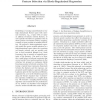110
click to vote
UAI
2008
15 years 2 months ago
2008
Decision circuits have been developed to perform efficient evaluation of influence diagrams [Bhattacharjya and Shachter, 2007], building on the advances in arithmetic circuits for...
101
Voted
UAI
2008
15 years 2 months ago
2008
This paper presents a natural extension of stagewise ranking to the the case of infinitely many items. We introduce the infinite generalized Mallows model (IGM), describe its prop...
109
click to vote
UAI
2008
15 years 2 months ago
2008
Nonparametric Bayesian models are often based on the assumption that the objects being modeled are exchangeable. While appropriate in some applications (e.g., bag-ofwords models f...
124
Voted
UAI
2008
15 years 2 months ago
2008
Gaussian Markov random fields (GMRFs) are useful in a broad range of applications. In this paper we tackle the problem of learning a sparse GMRF in a high-dimensional space. Our a...
121
click to vote
UAI
2008
15 years 2 months ago
2008
When related learning tasks are naturally arranged in a hierarchy, an appealing approach for coping with scarcity of instances is that of transfer learning using a hierarchical Ba...
123
Voted
UAI
2008
15 years 2 months ago
2008
Identifying co-varying causal elements in very high dimensional feature space with internal structures, e.g., a space with as many as millions of linearly ordered features, as one...
108
Voted
UAI
2008
15 years 2 months ago
2008
A graphical multiagent model (GMM) represents a joint distribution over the behavior of a set of agents. One source of knowledge aboutagents'behaviormaycomefromgametheoretic ...
87
Voted
UAI
2008
15 years 2 months ago
2008
In addressing the challenge of exponential scaling with the number of agents we adopt a cluster-based representation to approximately solve asymmetric games of very many players. ...
UAI
2008
15 years 2 months ago
2008
Formal languages for probabilistic modeling enable re-use, modularity, and descriptive clarity, and can foster generic inference techniques. We introduce Church, a universal langu...
131
click to vote
UAI
2008
15 years 2 months ago
2008
We consider the problem of efficiently learning optimal control policies and value functions over large state spaces in an online setting in which estimates must be available afte...




